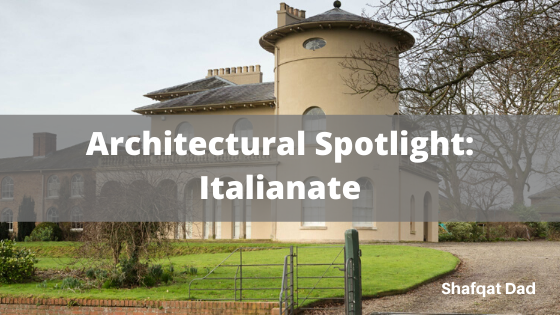Can you imagine a popular architectural style being created as a reaction to another style? This is what happened with the Italianate style. Italianate began in England in the 19th century, spanning 1802 to 1885. It was a reaction to the harsh lines of Formalism as well as an expansion of the Picturesque movement. The form of Italianate was taken from Italian farmhouses and villas. Gone were square windows and porches; arched windows and curved roofs characterized these homes. The curves suggest a flexibility that was not conveyed through earlier architectural styles.
There is one trait of Italianate that stands out: ornamentation. It makes sense that this style has more opulence than Formalism in that doors, windows, roofs, and porches stand out not only through colour or texture, but by shape. These homes were meant to remind people of the villas of Italy with exteriors in “stone” colours (e.g. pale grays, greens and blues). If the home had a light exterior, the trim was done in dark colours, such as olive, deep brown or red-brown. There are tall columns that flank front doors along with large panes of glass. Windows were tall and thin and had either u-shaped or pedimented crowns, often with decorated hoods in sets of three. Other notable details included corbels, deep eaves, and panel moldings. The roofs were low pitched with a cupola (tower). Also, the porches were grand with delicate trim reminiscent of Victorian architecture.
There are several notable examples of the Italianate style in England and Wales. Many were designed by famed architect John Nash. For example, Sandridge Park in Devon is a three-story home built for Dowager Lady Ashburton in 1805. This country home is a mix of Picturesque and Italianate with a cupola and turret. Cronkhill in Shropshire is another Italianate home designed by Nash. It was built in 1802 to reflect a Tuscan villa on the Attingham Estate. The home was restored in 2016 in which it was painted its original ochre colour. The Osborne House on the Isle of Wight is an expansive Italianate estate. It was designed as a country retreat by Prince Albert and Thomas Cubitt in 1845 (finished in 1850). Two towers, Tuscan-style terraces, and precisely planted gardens mark the royal estate. These are only a few of the Italianate mansions in England. Although the style is not popular today, we can still appreciate its reflection of Italy and beautiful ornamentation.

